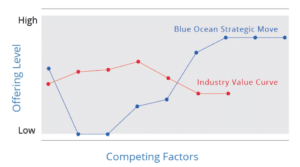I was working with a colleague on developing a Blue Ocean Strategy Canvas. If you are not familiar with the Strategy Canvas, it was developed by Chan Kim and Renée Mauborgne and is a central diagnostic tool and an action framework that graphically captures, in one simple picture, the current strategic landscape and the future prospects for an organization.

The horizontal axis on the strategy canvas captures the range of factors that an industry competes on and invests in, while the vertical axis captures the offering level that buyers receive across all of these key competing factors. A value curve or strategic profile is the graphic depiction of a company’s relative performance across its industry’s factors of competition.
The strategy canvas allows an organization to see in one simple picture all the factors an industry competes on and invests in, what buyers receive, and what the strategic profiles of the major players are. It exposes just how similar the players’ strategies look to buyers and reveals how they drive the industry toward the red ocean. Importantly, it creates a commonly owned baseline for change.
Using Porter’s 5 Forces, we had identified the competitors and substitute products, but were stuck on how to list the Competing Factors. Some, like price, came easily, but we knew there must be more. I had the sudden thought that using the Buyer Experience Cycle, part of Blue Ocean’s Buyer Utility Map, may prompt our creative thinking.
A buyer’s experience can usually be broken into a cycle of six stages, running more or less sequentially from purchase to disposal. For most industries there are six stages: PURCHASE, DELIVERY, then there is the USE stage that most businesses tend to focus on. Products and services may also require SUPPLEMENTS, that comes next. Over time, experience may include MAINTENANCE of the product or service. And finally, with many products and services, buyers eventually come to a DISPOSAL stage, which for services would be the cancellation stage.
Using these stages, we were able to identify more and more competing factors, until we had what we surmised were the factors that business in his market compete on.

